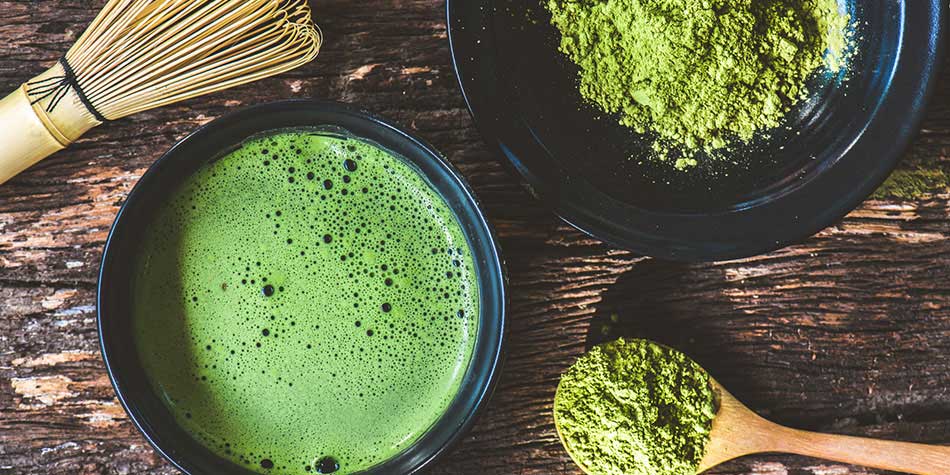
If you’ve scrolled through social media recently, you’ve likely seen countless images of an emerald-colored substance called matcha. A powder derived from the green tea leaves traditionally used in Japanese tea ceremonies, its popularity has boomed in the United States over the last few years. That's largely due to its supposed health benefits, like heart disease prevention.
So, how can you reap those rumored perks? And how do you prepare matcha? Nutritionist Kelsey Tiller of Grand Strand Medical Center in Myrtle Beach, South Carolina, talks us through everything you’ve ever wanted to know about this jade-hued trend.
What is matcha?
Matcha is made when dried green tea leaves are ground into a fine powder that can be mostly dissolved in liquid. Matcha fans say you’ll get many more nutrients from consuming matcha than you would from regular green tea; it’s more concentrated, since you’re consuming the whole tea leaves.
“Matcha is basically green tea on steroids. You get a higher return on the benefits when you switch out green tea for matcha powder,” says Tiller.
What are the health benefits?
Matcha's health benefits are still up for debate. While almost no clinical studies have looked at the benefits of matcha, numerous reviews have explored the benefits of green tea. And even then, experts do not have enough information to make concrete conclusions.
However, the National Center for Complementary and Integrative Health says:
- Green tea may increase mental alertness due to the caffeine content
- Although studies are limited, green and black teas might help control blood pressure and cholesterol
In one review of 11 randomized controlled trials on the subject, Cochrane – an independent organization known for its rigorous evidence reviews – cautiously made a statement on the issue. The organization concluded that, “limited evidence suggests that tea has favorable effects on cardiovascular disease,” and that higher quality trials are needed to confirm these findings.
The bottom line? Regular – moderate – matcha consumption might improve your health, but evidence is poor.
How to make matcha tea
You can add matcha powder to just about anything, but Tiller says the best way to reap the health benefits is to consume it in its purest form, which you can do by making tea.
To make the tea, sift 1 to 2 tablespoons of green tea powder into a cup, then add two ounces of hot water and whisk with a bamboo matcha whisk in a zig-zag motion until it’s frothy. Once it’s mixed, you can consume it straight out of the bowl.
More matcha recipes
In addition to making traditional matcha tea, it’s easy to infuse some of your favorite treats with matcha, too. Here are some ideas:
- Matcha smoothies: Try blending bananas, spinach, mango and green tea powder together for a refreshing treat.
- Matcha lattes: Whisk together hot water and two scoops of matcha powder in a mug. Then, whisk in any of your favorite flavorings, like cinnamon, vanilla bean paste or raw honey. Heat your milk, froth it if you have a frother, then pour it over the matcha powder mixture. If you prefer iced lattes, just use cold water and milk instead of hot.
- Matcha “ice cream”: Using your food processor, blend three frozen bananas, then slowly add in 3 tablespoons of your favorite kind of milk, like coconut or almond, and matcha powder. Blend until it has the consistency of soft serve ice cream; if you’d like a thicker consistency, freeze the finished product for an hour or more.
While you can control what goes into your homemade matcha treats, pay attention to the other ingredients in store-bought, matcha-flavored desserts and snacks – just because something calls for matcha powder doesn’t always mean it’s healthy. “A doughnut with green tea icing is still a doughnut with icing," says Tiller.
How to choose the right matcha
If you’re going to give matcha a try, opt for products with the fewest ingredients, says Tiller. You should choose vibrant green powders without added sweeteners or preservatives. You’ll also want to be sure that your matcha is high quality, too, since you’re consuming the whole leaf: look for Japanese matcha that’s steamed. These options usually contain fewer pollutants and are free of lead.
If you’re taking medications, especially blood thinners, or you’re pregnant or nursing, ask your doctor if it’s safe to consume matcha. Certain drugs may have adverse side effects when mixed with matcha.
Because matcha is highly concentrated and the creation process is longer and more involved, it’s going to cost more than regular green tea, so don’t be alarmed. There are different price points, too, depending upon the quality of the product.
Store matcha in a cool, dark place such as your refrigerator, or an air-tight container or bag. Once opened, it’s best used within two to three months.
Take a quick, confidential online health assessment
$webqFacilityNumber
Need a Physician?